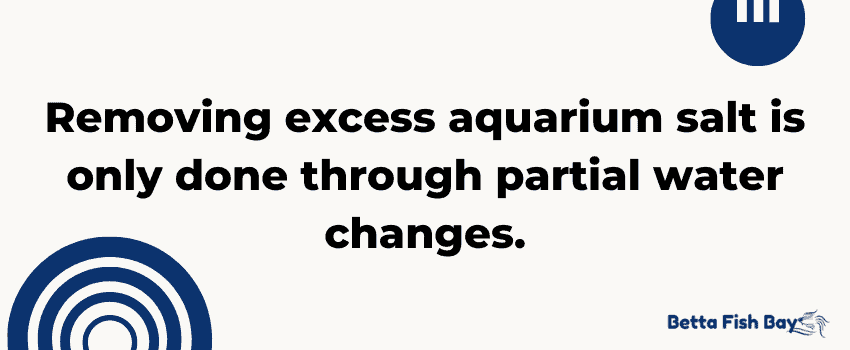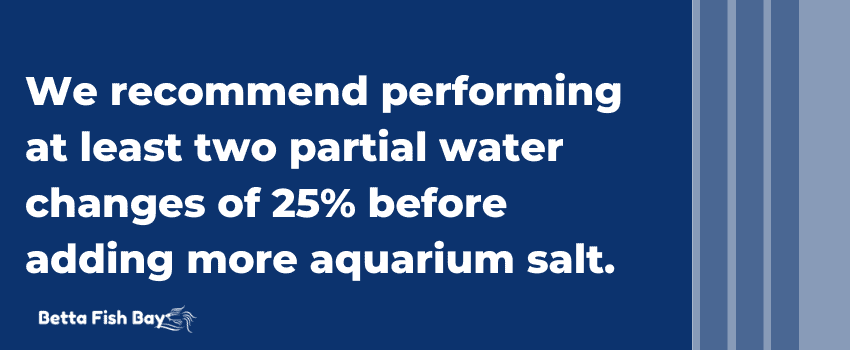Understanding how to use aquarium salt is a matter of life or death for your betta fish.
Aquarium salt treats mild cases of fin rot and fungal diseases.
But is aquarium salt safe for betta fish?
Small doses of aquarium salt are safe for betta fish and treat a variety of external parasites and fungal diseases. High doses of aquarium salt can cause skin burns, organ problems, and death in bettas. Aquarium salt is also dangerous for sensitive plants, scaleless fish, and snails.

Table of Contents
What Is Aquarium Salt and How Does It Benefit Betta Fish?
Aquarium salt differs from the table salt you sprinkle on your fries.
Both types of salt have the same chemical makeup.
The difference in table salt is additives like iodine, artificial colors, and flavor enhancers.
Aquarium salt comes from evaporated seawater and does not contain additives.

Marine salt is also unsuitable for a freshwater tank. This type of salt is for saltwater fish and contains pH buffers and trace minerals.
Regular salt and marine salt are not substitutes for aquarium salt.
Aquarium Salt Benefits for Betta Fish
Aquarium salt offers several benefits for bettas when used in the correct dosage. These benefits include:
- Faster wound healing
- Assists with slime coat production
- Protects against nitrite poisoning
- Improves kidney and gill function
- Removes mild cases of parasites, fungi, and bacteria
- Provides essential electrolytes
Low doses of aquarium salt stimulate a betta’s slime coat production. This beneficial mucus on the betta’s skin offers protection from parasites and microorganisms.
A healthy slime coat also prevents infection in torn fins and skin wounds.
Adding aquarium salt to your betta tank means your fish absorbs less water. This allows for better gill and kidney function because there is less pressure on these organs.
Parasites have a difficult time surviving an aquarium salt treatment.
Microorganisms and parasites lose fluids through osmosis and die. Water passes through the permeable membrane of the parasite’s body, causing dehydration.
Aquarium salt also protects against nitrite poisoning by lowering the levels of nitrite and nitrate in the water.
Treating Mild Betta Fish Illnesses with Aquarium Salt
A variety of mild betta fish diseases respond well to treatment with aquarium salt.
Aquarium salt works best when treating these mild illnesses:
- Open wounds
- Minor fungal infections
- External infections/parasites
- Minor fin rot
- Velvet
- White spot/Ich
- Mild bacterial infections
- Fish Lice
If you have a sick betta, aquarium salt works as a first-aid treatment when you do not have disease-specific medication.
Severe betta illnesses need a stronger medication than aquarium salt.
The following common illnesses are not curable with aquarium salt:
- Columnaris (cotton wool disease)
- Swim bladder disease
- Major fin rot
- Major fungal infection
- Popeye
- Dropsy
- Flukes
You may treat Columnaris with aquarium salt, but only an antibacterial fish medication will cure it.
Major cases of fin rot and fungal infection also need stronger medication.
Aquarium salt may help with bloating from swim bladder disorder or dropsy, but it is not a cure.
Popeye may worsen with an aquarium salt treatment. Seachem’s Kanaplex medication and erythromycin are better treatment options.
Learn more about treating and preventing betta illnesses with our article on common betta fish diseases.
How Much Aquarium Salt Should You Add to the Water?
You must be careful when adding aquarium salt to your betta tank.
Sodium chloride does not dissolve in aquarium water. Removing excess aquarium salt is only done through partial water changes.

A high salt concentration kills beneficial bacteria and leads to poor water quality.
Heavy salinity also causes health issues in your betta fish.
There are three dosages of salt based on disease treatment.
A mild dose consists of one tablespoon of salt for every three gallons of water.
Dissolve the aquarium salt in some tank water before adding it to the betta tank. This prevents burns on your betta caused by direct contact with salt.
This dose of salt treats mild fin rot and external bacterial and fungal diseases.
The aquarium salt increases slime coat production in your betta. Excess mucus prevents parasites and microorganisms from latching onto your betta’s body.
If a mild dose of salt does not work after 4-5 days, you may use a medium dose. One tablespoon of salt for every two gallons of water is a medium dose.
Keep your betta in this mild dose for ten days. If there are no signs of improvement, move to a higher dose.
The highest dose you may use is one tablespoon of salt per gallon of water. Do not use a high dose in a tank with snails, scaleless fish, or plants.
If you must use a stronger treatment for your betta fish, do not add aquarium salt to the entire tank.
There are two alternative methods of treating your betta.
Salt Bath
You need two containers for a salt bath treatment.
Place one tablespoon of salt in one gallon of tank water in the first container.
The second container only needs 1/4 tablespoon of salt in one gallon of tank water.
Heat the water in both containers between 78-80° degrees Fahrenheit (27° C).
After heating both containers of water, place your betta in a plastic bag of regular tank water. Float the bag in the first container for 10-15 minutes before releasing your betta.
Let your betta swim in the first tank for 5-8 minutes. After 5-8 minutes, put your betta in the second container for three minutes.
After three minutes, place your betta back in a plastic bag of untreated tank water and float it in the home tank for 10-15 minutes.
This prevents your betta from going into temperature shock between the different environments.
Salt Dip
Add one tablespoon of aquarium salt to two gallons of tank water. Ensure the water temperature is between 78-80° degrees Fahrenheit (27° C).
Put your betta in this tank for three minutes. Check your fish for signs of distress.
After three minutes, place your betta back in its original tank.
If your betta’s condition improves after either of these methods, you may repeat them 1-2 times per day for no longer than eight days.
Frequent salt baths are harmful. Do not continue treatment if your betta’s condition seems worse.
How Often Should You Add Aquarium Salt to the Water?
Only add aquarium salt to your tank after performing a partial water change.
We recommend performing at least two partial water changes of 25% before adding more aquarium salt. Do not add salt to these two partial water changes.

Check on your betta’s condition after the two clean water changes.
If your betta is still sick, you may restart the process of adding aquarium salt.
Only dose the amount of water you put into the tank. Do not dose for the entire tank.
For complete safety, use a quarantine tank for aquarium salt treatments.
A quarantine tank lowers the risk of killing beneficial bacteria or harming other aquatic life in your original tank.
Can You Use Aquarium Salt With Water Conditioners?
You must use a water conditioner whenever you perform a partial water change for your betta tank.
Water conditioners with dechlorinators remove harmful chemicals from tap water.
Chemicals like chlorine and chloramine are toxic and cause chemical burns on betta fish. Chemical burns on the gills cause breathing issues, and your betta may suffocate.
Add the water conditioner to the tap water before adding the salt.
Most water conditioners are for freshwater and saltwater and will not affect the aquarium salt in any way.
Check out our guide on water conditioners for bettas to pick the best options out there.
Can Betta Fish Live in Freshwater Without Aquarium Salt?
Many betta owners treat their aquariums with salt as a preventative measure.
This is not always a good practice, especially if snails or plants are in the tank.
Bettas are freshwater fish, so adding salt to their tank is unnecessary.
While betta fish can tolerate small amounts of salt, high salt concentrations can harm them.

Long-term exposure to salt can burn a betta’s skin and gills, even in small amounts.
Over time, aquarium salt also damages beneficial bacteria in the tank.
Scaleless fish and snails are also prone to the harmful effects of aquarium salt.
Aquarium salt depletes the protective slime coat of scaleless fish. This makes them prone to infections and parasites.
Snails suffer the same fate as parasites and microorganisms. Osmosis dries out their mucus and causes dehydration.
Can You Use Aquarium Salt in a Planted Tank With Betta Fish?
Most freshwater aquatic plants do not survive an aquarium salt treatment.
Aquarium salt dehydrates fragile plant cells, causing them to die.
Some aquatic plants are hardy and more resistant to the effects of aquarium salt, such as:
- Java fern
- Java moss
- Anacharis
- Anubias
- Moneywort
- Seaside Brookweed
Even though these plants are hardy, high concentrations of aquarium salt are still deadly.
If you have a planted tank, we recommend treating your betta with aquarium salt in a separate quarantine tank.
Since there are no plants in the quarantine tank, you may add aquarium salt or other medications as necessary for your betta fish.
Setting Up a Quarantine Tank for Your Betta
A large quarantine tank is easier to maintain than a smaller one. Temperature fluctuations and poor water quality are common in tanks less than 10 gallons.
You also need a heater and filter for your quarantine tank.
Water parameters in a quarantine tank must be like the original tank. This avoids temperature shock in your betta.
Some medications reduce oxygen in the water, causing suffocation in your betta. Prevent this by adding an air stone or air bubbler.
Sick betta fish are usually stressed. Reduce stress by adding hiding places for your betta’s sense of security.
Lighting is also important in a quarantine tank.
Betta fish need at least eight hours of light every day. Periods of light and darkness help your betta regulate its eating and sleeping habits.
Are There Any Risks of Using Aquarium Salt With Betta Fish?
If you follow the correct dosages for aquarium salt treatments, there is no risk of harm to your betta fish.
The biggest issue with aquarium salt treatments is overdosing.
Remember, aquarium salt does not dissipate in the tank water. Removal of aquarium salt is only possible through water changes.
Once you dose your betta tank with aquarium salt, you must be careful.
Never add a second dose of aquarium salt to your betta tank without doing at least two partial water changes with clean water.
High salt levels affect not only your betta but also the delicate ecosystem of your tank.
Establishing a nitrogen cycle is challenging and time-consuming when you destroy beneficial bacteria.
Your water parameters must remain stable for your betta’s health.
Too much salt could kill your betta, either through suffocation or infections in skin burns.
There is also a risk of making certain betta illnesses worse with aquarium salt.
Some external bacteria are resistant to salt treatments. You are better off treating these types of bacterial infections with an antibiotic.
Aquarium salt treatments may also irritate an already-stressed sick betta.
Are There Alternatives to Using Aquarium Salt for Bettas?
Rock salt and Kosher salt do not contain iodine or other additives. Both of these salts are safe alternatives to aquarium salt.
Table salt, marine salt, and sea salt are unsafe for bettas because of additives like iodine, caking agents, and flavor enhancers.
Several disease-specific medications are available in pet stores and online. These medications are often more effective at treating betta fish illnesses.
Aquarium salts are a good choice if these medications are unavailable.
Not all fish diseases are curable by aquarium salt. In some cases, aquarium salt may do more harm than good.
Treating a healthy betta with aquarium salt is not advised. The salt may cause irritation and injury to your betta.
Hold the Salt
Small amounts of aquarium salt are safe for your betta.
Aquarium salt is only effective in treating mild diseases.
Severe illnesses are best treated with medications like Seachem’s Kanaplex or erythromycin.
Avoid adding aquarium salt to a healthy betta tank, especially when there are live plants.
Unnecessary aquarium salt treatment is more harmful than helpful.


